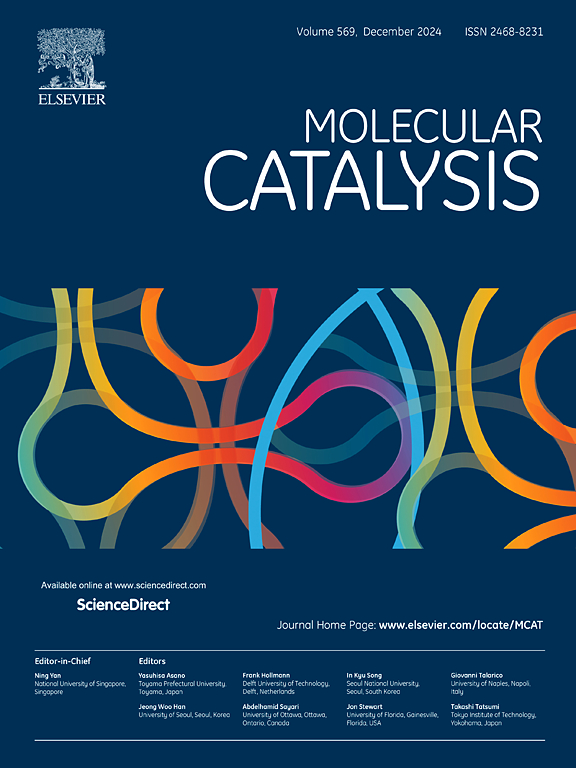结合DFT和kMC分析揭示了Cu-Cr催化剂上马来酸二甲酯加氢的反应机理和动力学性质
IF 4.9
2区 化学
Q2 CHEMISTRY, PHYSICAL
引用次数: 0
摘要
1,4-丁二醇(BDO)是一种精细化工原料,在生产可降解塑料中起着重要作用。马来酸二甲酯(HDMM)加氢制BDO因其催化剂成本低、选择性高而备受业界青睐。然而,在铜铬催化剂上HDMM制BDO的动力学方程和最佳条件尚不清楚,这阻碍了先进工业反应器设计和生产工艺的发展。本文采用DFT和kMC相结合的方法建立了Cu-Cr(111)表面模型,研究了HDMM过程的反应网络。活化势垒和贝德电荷分析表明,Cu0和Cr分别是酯加氢和醇羟基裂解的活性中心。通过TOF和覆盖度分析,确定了γ-丁内酯(GBL)、BDO和四氢呋喃(THF)形成的主要途径和关键中间体。用速率控制度的概念观察了BDO生成速率决定步长随温度的变化。在反应网络的基础上,提出了一种构建本征动力学方程模型的方法,并对该模型进行非线性优化和线性/非线性拟合得到相关参数。对HDMM过程中反应的动力学和热力学性质分析表明,温度和总压越高,h2 -酯比越低,反应速率越高,不同产物对反应条件的响应也不同。针对不同的产品,确定了最佳工艺条件。本研究试图从微观尺度跨越到中尺度,为HDMM工艺的新型反应器设计提供理论支持,并为通过多尺度模拟研究C4+复合反应体系的动力学性质提供可能性。本文章由计算机程序翻译,如有差异,请以英文原文为准。

Revealing the reaction mechanism and kinetic properties for dimethyl maleate hydrogenation on the Cu-Cr catalysts combined DFT with kMC analysis
1,4-Butanediol (BDO) is a fine chemical raw material that plays a significant role in the production of degradable plastics. The hydrogenation of dimethyl maleate (HDMM) to BDO is a highly favored technology the industry for its low-cost catalysts and high selectivity. However, the kinetics equation and optimal conditions for HDMM process to BDO on copper-chromium catalysts are still unclear, which has hindered the development of the design of advanced industrial reactors and production processes. Herein, the Cu-Cr(111) surface model was constructed by combining DFT and kMC to investigate the reaction network of the HDMM process. The analysis of the activation barrier and Bader charge revealed that Cu0 and Cr act as the active centers for ester hydrogenation and alcohol hydroxyl cleavage, respectively. The dominant pathways and key intermediates for the formation of γ-butyrolactone (GBL), BDO, and tetrahydrofuran (THF) were claimed by TOF and coverage analysis. Changes in the rate-determining step with temperature for BDO formation were observed by the concepts of degree of rate control. Based on the reaction network, a method was proposed to construct the intrinsic kinetic equation models, which are subjected to nonlinear optimization and linear/nonlinear fitting to obtain relevant parameters. Analysis of the kinetic and thermodynamic properties of reactions in the HDMM process revealed that the higher temperature and total pressure, the lower H2-ester ratio, the higher reaction rates, and different products have different responses to the reaction conditions. Optimal conditions were determined to target different products. This study attempted to span from the microscale to mesoscale, providing theoretical support for novel reactor design for the HDMM process and possibilities for studying the kinetic properties of C4+ complex reaction systems through multi-scale simulation.
求助全文
通过发布文献求助,成功后即可免费获取论文全文。
去求助
来源期刊

Molecular Catalysis
Chemical Engineering-Process Chemistry and Technology
CiteScore
6.90
自引率
10.90%
发文量
700
审稿时长
40 days
期刊介绍:
Molecular Catalysis publishes full papers that are original, rigorous, and scholarly contributions examining the molecular and atomic aspects of catalytic activation and reaction mechanisms. The fields covered are:
Heterogeneous catalysis including immobilized molecular catalysts
Homogeneous catalysis including organocatalysis, organometallic catalysis and biocatalysis
Photo- and electrochemistry
Theoretical aspects of catalysis analyzed by computational methods
 求助内容:
求助内容: 应助结果提醒方式:
应助结果提醒方式:


